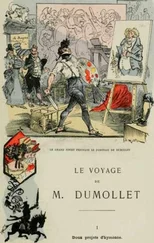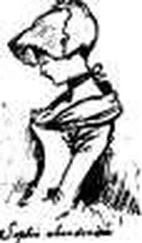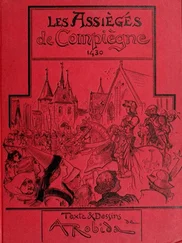Albert Robida - Yester-year; ten centuries of toilette from the French of A. Robida
Здесь есть возможность читать онлайн «Albert Robida - Yester-year; ten centuries of toilette from the French of A. Robida» весь текст электронной книги совершенно бесплатно (целиком полную версию без сокращений). В некоторых случаях можно слушать аудио, скачать через торрент в формате fb2 и присутствует краткое содержание. Жанр: Старинная литература, на английском языке. Описание произведения, (предисловие) а так же отзывы посетителей доступны на портале библиотеки ЛибКат.
- Название:Yester-year; ten centuries of toilette from the French of A. Robida
- Автор:
- Жанр:
- Год:неизвестен
- ISBN:нет данных
- Рейтинг книги:4 / 5. Голосов: 1
-
Избранное:Добавить в избранное
- Отзывы:
-
Ваша оценка:
- 80
- 1
- 2
- 3
- 4
- 5
Yester-year; ten centuries of toilette from the French of A. Robida: краткое содержание, описание и аннотация
Предлагаем к чтению аннотацию, описание, краткое содержание или предисловие (зависит от того, что написал сам автор книги «Yester-year; ten centuries of toilette from the French of A. Robida»). Если вы не нашли необходимую информацию о книге — напишите в комментариях, мы постараемся отыскать её.
Yester-year; ten centuries of toilette from the French of A. Robida — читать онлайн бесплатно полную книгу (весь текст) целиком
Ниже представлен текст книги, разбитый по страницам. Система сохранения места последней прочитанной страницы, позволяет с удобством читать онлайн бесплатно книгу «Yester-year; ten centuries of toilette from the French of A. Robida», без необходимости каждый раз заново искать на чём Вы остановились. Поставьте закладку, и сможете в любой момент перейти на страницу, на которой закончили чтение.
Интервал:
Закладка:
In 1680 a revolution in head-dresses took place. One day, at a royal hunting-party, the hat of the Duchesse de Fontanges (who had replaced Montespan in the favour of the Monarch), was blown off, and she employed her ribbon garter to confine her disordered locks, tying it in front with a smart rosette. Every thing a favourite does is of course charming and delightful. The fine gentlemen went into ecstasies over the ' inspiration/ the fine ladies were equally enchanted, and the next day everybody's hair was un-dressed à la Fontanges.
The Fontanges style became ' the rage,' and reigned for several years, but with alterations and additions. Ultimately it became an edifice of lace, ribbons, and hair, with the characteristic peak of lace mounted on brass wire, which Saint-Simon tells us was two feet high. Each article composing the structure had its distinctive name.
Tliis ftxsliion, whicli had so trifling an origin, lasted a long time, but at length it ceased to be pleasing to the King, who no doubt cared only for the severe style of Scarron's widow.
The Princess Palatine, Princess Charlotte of Bavaria, daughter of the Elector Palatine, came to France in 1G71 to be married to Monsieur the King's brother—whose first wife was the daughter of Charles I. of Ençfland and Henrietta Maria—and set a fashion, by wearing a short cape to cover her shoulders, which were too much bared by the very low-cut bodices then worn. These little capes were speedily adopted by all the ladies, and were called ' palatines.'
The romance of fashion, still gallant and heroic, now gives us Steinkirks, for it was the age of dandified chivalry, and bravery ' à la
^ The mode was imported into England, wliere the capes were called 'pelerines,' tlie first of tliem having been made in fur.
mousquetaire,' " The jDosition will be difficult to cany," said a colonel to his troops, just before a charge. " So much the better, gentlemen, we shall have all the more pleasure in tellino- our mistresses of the affair."
At the battle of Steinkirk, in which William of Orange was beaten by the Maréchal de Luxembourg, the Prince de Conti and the Due de Vendôme, with Philip of Orleans, who was then only fifteen, charged with the cavalry; their dress was in disorder, their lace cravats being untied and flying in the wind. In the joy of victory the fashion of ' negligent ' lace cravats was adopted, and all the women wore Steinkirks.
The wealthy country dames, and the ladies of the lesser nobility, imitated the modes and shapes of the Court costumes, and the bourgeoises followed suit at a humbler distance. Furetière in his bourgeois novel, and Sébastien Leclère in his etchings, show us "the imitative crew " with their coquettish ways, disdaining the homely hood of their mothers, wearing big 'Lands' ami |)cail necklaces, bedizened bodices, and almost as great a quantity of lace and ribbons as the Court ladies
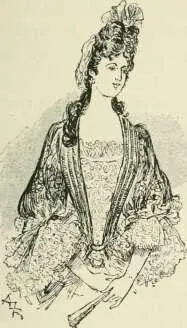
Early Foutauges head-dress.
displayed at Versailles. The rash Furetière even lets out that they were in the habit of borrowing diamonds for great occasions, and going to churcli witli a borrowed lackey to carry the tail of their gowns.
Let us take Moliere's serving-maid as a type of the woman of the people ; she is a good girl. Sébastien Leclère has drawn her also with her plain coif, her raised skirt and her camisole with large basques, which is the ' hongreline,' or jacket of the soldiery of Louis Treize, afterwards adopted by ladies.
The shopkeepers and market-women whom he also drew wore wide bands and lace, with an air of dignity and majesty which proves that they too were of the ' great century.'
The brilliant and festive period of the reign of the Great King was in reality the shortest, the pivot turned in 1680, when Mme. de Main-tenon, whom the King married privately five years later, began to acquire influence over him.
No more shall we go to the woods, all the roses are gathered, almost all the laurels also.
The reign of Mme. de Maintenon covered the respectable period of thirty-five years. Thus the Sun-King, whom we always picture to our fancy with the pomp and splendour of his youth around him, in all the lustre of his glory and gallantry, amid his be-ribboned courtiers, presiding over fetes, balls, and carrousels, shining and shone upon by whole constellations of brilliant beauties—this great king became prematurely an old, morose, and bored monarch. It is true that he retained his taste for pomp, but with an affectation of formal solemnity, with, so to speak, a sumjituous severity.
The great century was a wearisome one, a time of gilded boredom in full dress and solemn wigs. The King, repenting him of the follies of his youth, and having turned to devotion and austerity, expected everybody else to do as he did.
Fashion changed at once. The dress of both men and women Avas simplified ; ornaments that were considered too showy or too becoming, bright colours, and the flowered stuffs which had formerly charmed Court and City, disappeared, to give place to more discreet and sober attire.
This lasted until the time when Louis Quatorze himself, having had enough of his own moroseness and the prim coifs of Mme. de Maintenon, thought fit to request the fine gentlemen and the great ladies to revert to the display and splendour of former days, before devotion had become the fashion at his gloomy Court. It is needless to say that the royal invitation met with a joyful response, and that luxurious dress immediately reappeared.
The ladies of the close of the great century were dressed in splendid flowered stuffs gorgeously trimmed. The gowns, opening upon bodice fronts of fine lace, were of brocade or damask interwoven with gold, the skirts were raised and draped under a small apron of lace. The latter was not the most tasteful adjunct of their attire, it did not go w^ell with outdoor dress.
The high points of the Fontanges head-dress were still to be seen, and the edifice had now become complicated and extravagant, with lace strings hanging at the back.
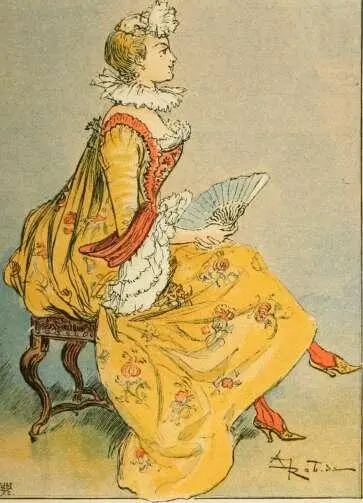
sous LA REGENCE.
Skirts were adorned with furbelows and ' pretintailles/ the former, invented by one Lançjlée, the son of a waitini-'-maid of the queen's, who had become the arbiter of taste
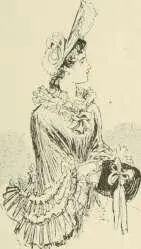
At the close of the great century.
and the oracle of fashion at Court, were rows of quilled flounces placed upon the straight skirt, but not on the loose-trained over-skirt, which was raised at the sides.
The ' pretintailles ' of this period, were cut-out brocade flowers of all sizes and colours, applied to the material, a showy mode of decoration which made the wearers look as though they had made their gowns out of room-hanffinofs or arm-chair covers.
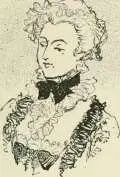
Head-dress worn at home.
VIII.
THE EIGHTEENTH CENTURY.
The Regency—Follies and frivolities—Cythera at Paris —The Watteaii fashions—'Flying' gowns—The birth of the panier — Criardes —' Considerations ' and the Maîtres des Requêtes — Mme. de Pompadour— The Fan—The Promenade de Longchamps—Coaches and Chairs—Winter fashions.
France had experienced great trials and reverses after a long period of glory and magnificence, and was sorrowfully contemplating the slow and melancholy setting of the Sun-King. She had lived for many years in an atmosphere of oppressive ennui under the rule of the old monarch and the grim-visaged lady, his companion, and she realized with a sensible relief that Louis was in his vault at St. Denis, and Mme. de Maintenon in rigid retreat at St. Cyr. All the repressed youth, all the restrained frivolity, all the longing for pleasure of the whole nation revived, and the great madness of the Regency period broke out.
Читать дальшеИнтервал:
Закладка:
Похожие книги на «Yester-year; ten centuries of toilette from the French of A. Robida»
Представляем Вашему вниманию похожие книги на «Yester-year; ten centuries of toilette from the French of A. Robida» списком для выбора. Мы отобрали схожую по названию и смыслу литературу в надежде предоставить читателям больше вариантов отыскать новые, интересные, ещё непрочитанные произведения.
Обсуждение, отзывы о книге «Yester-year; ten centuries of toilette from the French of A. Robida» и просто собственные мнения читателей. Оставьте ваши комментарии, напишите, что Вы думаете о произведении, его смысле или главных героях. Укажите что конкретно понравилось, а что нет, и почему Вы так считаете.

